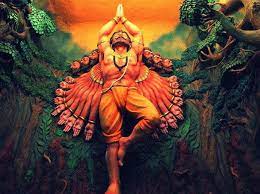
The story of Goddess Kali: Characters and Themes
The story of Goddess Kali is one of the most fascinating tales of Hindu mythology. As a goddess of destruction and transformation, Kali represents the darker aspects of life, such as death, violence, and chaos. But she is also a symbol of motherly love and protection, and her story is rich with complex characters and themes.
The Origins of Kali

Kali is said to have emerged from the brow of the goddess Durga, during a battle with the demon Mahishasura. As the demon grew more powerful, the gods realized they needed a powerful warrior to defeat him. They turned to Durga, who was created by the combined energies of several gods and goddesses.

Durga was fierce and unstoppable, but even she was unable to defeat Mahishasura. As the battle raged on, Durga began to glow with a bright light, and from her forehead emerged Kali. With her black skin, wild hair, and blood-red eyes, Kali was a terrifying sight, but she was also the only one capable of defeating Mahishasura.

Kali quickly sprang into action, taking on the demon's army with her fierce sword and deadly gaze. In the end, she was able to defeat Mahishasura and restore order to the world.
The Characters of Kali's Story
Kali is often portrayed as a solitary figure, but her story is filled with other characters who play important roles in her mythology. Here are a few of the most significant:
Durga:

As the mother of Kali, Durga is an important figure in her story. Durga is a goddess of strength and power, and her ability to create Kali shows just how potent her energies can be.
Mahishasura:

The demon who Kali defeats is a formidable opponent, with the ability to take on both gods and humans. His defeat is a testament to Kali's power and the necessity of destruction in the cycle of life.
Shiva:

Kali is often depicted standing on the body of the god Shiva, with her tongue hanging out and her hair flying wild. Shiva represents the god of destruction and transformation, and his willingness to be defeated by Kali shows his respect for her power.
Radha:

In some stories, Kali is said to have had a close relationship with the Hindu goddess Radha. Radha represents love and devotion, and her friendship with Kali shows that even the darkest of goddesses can have a softer side.
The Themes of Kali's Story
The story of Kali is rich with themes that are still relevant today. Here are a few of the most significant:
The Power of Women:

Kali is a goddess of destruction and transformation, but she is also a symbol of female strength and power. Her ability to defeat Mahishasura shows that women are capable of great things, and her mythology has been an inspiration to women for centuries.
The Necessity of Destruction:

Kali is often associated with death and destruction, but these themes are important in Hindu mythology. The destruction of old things is necessary for new growth to occur, and Kali reminds us that sometimes we need to let go of the old in order to make way for the new.
The Complexity of Emotions:

Kali is often portrayed as a fierce and terrifying figure, but she is also capable of great love and compassion. Her relationship with Radha shows that even the darkest of emotions can have a softer side.
The Cycles of Life:

Kali is a goddess of transformation, and her mythology reflects the cycles of birth, death, and rebirth that are a fundamental part of life. She reminds us that even in the darkest moments, there is always the potential for transformation and new beginnings.
The Importance of Devotion:

In many Hindu traditions, devotion to the gods and goddesses is considered to be a crucial part of spiritual practice. Kali is no exception, and her mythology often emphasizes the importance of devotion and surrender to her power.
The Intersection of Light and Dark:

Kali is a goddess of darkness, but she is also associated with the light of consciousness. Her mythology emphasizes the idea that light and dark are not opposing forces, but rather two sides of the same coin.
The Power of Fear:

Kali is often portrayed as a terrifying figure, and her ability to inspire fear is considered to be one of her greatest powers. In Hindu mythology, fear is seen as a powerful tool for transformation and awakening, and Kali reminds us that sometimes we need to confront our fears in order to grow and evolve.
In Conclusion
The story of Kali is a complex and multifaceted one, full of rich characters and powerful themes. As a goddess of destruction and transformation, Kali represents the darker aspects of life, but she is also a symbol of female strength, love, and devotion. Her mythology reminds us that even in the darkest moments, there is always the potential for transformation and new beginnings, and her power to inspire fear shows us the importance of confronting our fears in order to grow and evolve.

